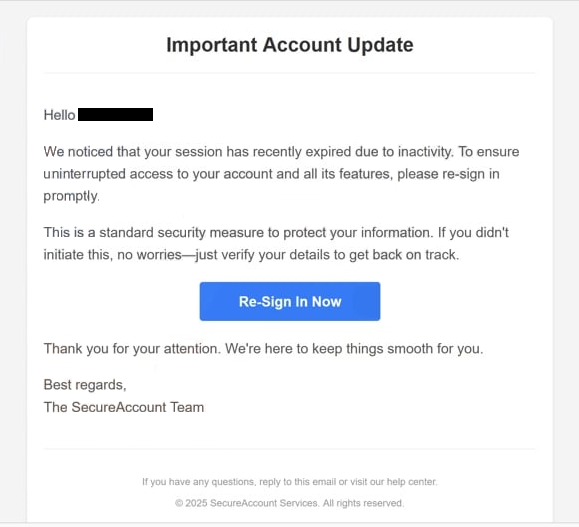Remove “Important Account Update” email
The “Important Account Update” email is part of a phishing campaign that tries to steal your email account login credentials. The email is made to look like a notification from your email service provider. It falsely informs you that your session has expired due to inactivity and that you need to re-sign in to continue using your account. The email includes a link that leads to a phishing site that asks for your email account login credentials. If you type them in on the phishing site, they will be sent to the malicious actors operating this phishing campaign. This could allow them to hijack your account.
The “Important Account Update” email is an example of a generic phishing attempt that is easy to identify as malicious. It claims that your session has expired due to inactivity and prompts you to log back in to continue using your account. The email encourages you to click on the “Re-sign in now” button. While it tries to imitate a security alert from your email service provider, it does not do so convincingly.
If you click the link, you are redirected to a phishing site that resembles the official login page of your email provider. This fake page asks you to enter your login details, which are then captured by the cybercriminals behind the phishing campaign. They might use this stolen information for their own gain or sell it to others with malicious intentions.
Email login credentials are particularly valuable because email accounts often contain years’ worth of sensitive information. Furthermore, email accounts are typically linked to a variety of other accounts. Gaining access to an email account allows cybercriminals to exploit it and potentially engage in blackmail.
The full text from the “Important Account Update” phishing email is below:
Subject: System Notification:
Important Account Update
Hello -,
We noticed that your session has recently expired due to inactivity. To ensure uninterrupted access to your account and all its features, please re-sign in promptly.
This is a standard security measure to protect your information. If you didn’t initiate this, no worries—just verify your details to get back on track.
Re-Sign In Now
Thank you for your attention. We’re here to keep things smooth for you.
Best regards,
The SecureAccount TeamIf you have any questions, reply to this email or visit our help center.
© 2025 SecureAccount Services. All rights reserved.
Signs of a phishing email
Some phishing emails can be immediately identified as such. The “Important Account Update” email is a good example. The email uses your email username to address you, and that is a dead giveaway. Correspondence from your email provider will always address you by name, or rather, the name you used when making an account. The same goes for all companies whose services you use/have used. Malicious emails may not address you at all, use your username, or use generic words like “User”, “Member”, or “Customer” when addressing you.
A lot of phishing campaigns target many users with the same exact emails, which makes them easy to identify. However, phishing attempts aimed at high-profile individuals or organizations are generally more sophisticated and difficult to detect. Fortunately, most people tend to encounter the more common, generic phishing emails.
When you receive unsolicited emails, the first step is to verify the sender’s email address. In some cases, the sender’s address is obviously malicious, as seen with the “Important Account Update” email. However, we should mention that malicious actors often use tactics to make email addresses look legitimate and professional. Therefore, it’s a good idea to conduct research on these addresses before taking any action. A quick search online is often enough. We should also mention that cybercriminals can use spoofing techniques to make it seem like their emails are sent from users’ own accounts, but that is not the case.
Also, be on the lookout for spelling and grammar mistakes. Legitimate senders typically produce well-written emails, while low-quality phishing attempts often include various mistakes. Even if an email appears more polished, look for awkward phrasing.
Lastly, refrain from clicking on links in unsolicited emails. If you receive an email saying there’s an issue with your account, it’s best to log in directly to the account to check for any problems, rather than clicking the links provided in the email. Additionally, always scan attachments from unsolicited emails with anti-malware software or use services like VirusTotal to ensure they are safe to open.
Remove “Important Account Update” phishing email
If you get this “Important Account Update” email, you can safely ignore its content and delete it right away. If you have already interacted with the email, clicked on any links, or entered your login information, change your password immediately, assuming you still have access to your account. If you can’t access the account anymore, use all available recovery options to regain access. To reduce the risk of compromising other accounts, disconnect your email from any linked accounts if you can’t access your email account.
Site Disclaimer
WiperSoft.com is not sponsored, affiliated, linked to or owned by malware developers or distributors that are referred to in this article. The article does NOT endorse or promote malicious programs. The intention behind it is to present useful information that will help users to detect and eliminate malware from their computer by using WiperSoft and/or the manual removal guide.
The article should only be used for educational purposes. If you follow the instructions provided in the article, you agree to be bound by this disclaimer. We do not guarantee that the article will aid you in completely removing the malware from your PC. Malicious programs are constantly developing, which is why it is not always easy or possible to clean the computer by using only the manual removal guide.

